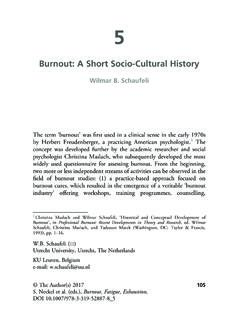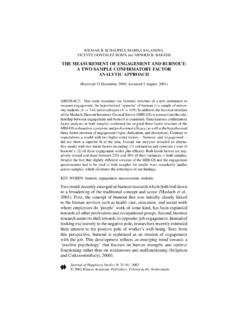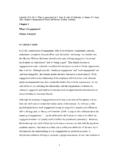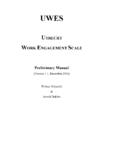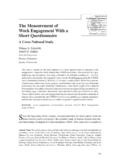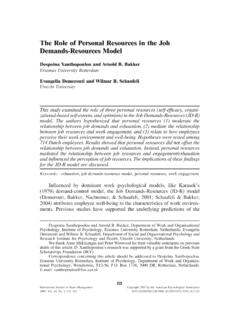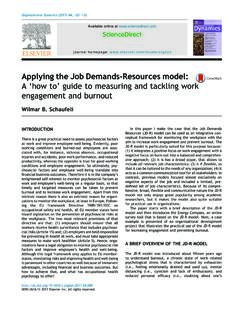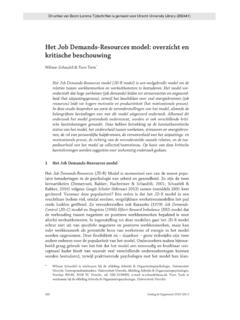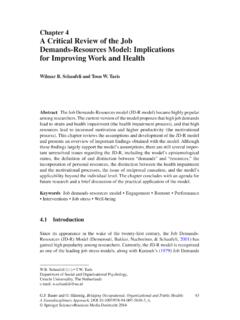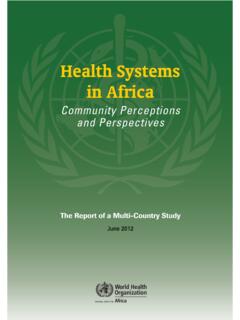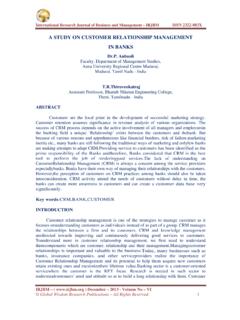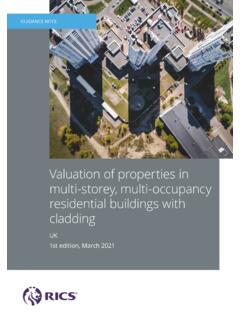Transcription of Job demands, job resources, and their relationship with ...
1 Journal of Organizational BehaviorJ. Organiz. , 293 315 (2004)Published online in Wiley InterScience ( ).DOI: demands, job resources , and theirrelationship with burnout andengagement: a multi-sample studyWILMAR B. SCHAUFELI* AND ARNOLD B. BAKKERD epartment of Psychology and Research Institute Psychology and Health, Utrecht University, Utrecht,The NetherlandsSummaryThis study focuses on burnout and its positive antipode engagement. A model is tested inwhich burnout and engagement have different predictors and different possible equation modeling was used to simultaneously analyze data from four independentoccupational samples (totalN 1698). Results confirm the hypothesized model indicatingthat: (1) burnout and engagement are negatively related, sharing between 10 per cent and25 per cent of their variances; (2) burnout is mainly predicted by job demands but also by lackof job resources , whereas engagement is exclusively predicted by available job resources ;(3) burnout is related to health problems as well as to turnover intention, whereas engagementis related only to the latter; (4) burnout mediates the relationship between job demands andhealth problems, whereas engagement mediates the relationship between job resources andturnover intention.
2 The fact that burnout and engagement exhibit different patterns of possiblecauses and consequences implies that different intervention strategies should be used whenburnout is to be reduced or engagement is to be enhanced. Copyright#2004 John Wiley& Sons, states are not popular in psychology. Based on an electronic search ofPsychologicalAbstracts, Myers (2000) calculated that negative emotions outnumber positive emotions by a ratioof 14 to 1. The same is true for occupational health psychology: a simple count of articles that appearedfrom 1996 onwards in theJournal of Occupational Health Psychologyreveals that negativework-related outcomes outnumber the positive outcomes by a comparable ratio of 15 to 1. So, it isnot surprising that the emergingpositive psychologyproposes a shift from this traditional focus onweaknesses and malfunctioning towards human strengths and optimal functioning (Seligman &Csikszentmihalyi, 2000).
3 A similar switch from burnout towards its opposite engagement hasrecently been put forward by Maslach, Schaufeli, and Leiter (2001). In the current article we proposeReceived 10 October 2002 Revised 6 March 2003 Copyright#2004 John Wiley & Sons, 27 August 2003* Correspondence to: Wilmar B. Schaufeli, Department of Psychology, Utrecht University, PO Box 80140, 3508 TC Utrecht,The Netherlands. E-mail: comprehensive model to predict burnout and engagement from job demands and job resources , andto relate both types of employee well-being to potential individual and organizational and engagementBurnout is a metaphor that is commonly used to describe a state of mental weariness. Originally, burn-out was considered to occur exclusively in the human services among those who do people work ofsome kind (Maslach & Schaufeli, 1993).
4 However, gradually it became clear that burnout also existsoutside the human services (Maslach & Leiter, 1997). Consequently, the original version of theMaslach Burnout Inventory (Maslach & Jackson, 1986) was adapted for use outside the humanservices; this new version was called MBI General Survey(MBI-GS: Schaufeli, Leiter, Maslach, &Jackson, 1996). The three dimensions of the MBI-GS parallel those of the original MBI, in the sensethat they are more generic and do not refer to other people one is working with. The first dimension exhaustion measures fatigue without referring to other people as the source of one s tiredness. Thesecond dimension cynicism reflects indifference or a distant attitude towards work in general, notnecessarily with other people. Finally,professional efficacyencompasses both socialandnon-socialaspects of occupational accomplishments.
5 In the present study , the MBI-GS is used to measure burn-out; high scores on exhaustion and cynicism, and low scores on professional efficacy, are indicative engagement is assumed to be the positive antipode of burnout. Or, as Maslach and Leiter (1997,p. 34) put it: Energy, involvement, and efficacy these are the direct opposites of the three dimen-sions of burnout. In their view, burnout is an erosion of engagement, whereby Energy turns intoexhaustion, involvement turns into cynicism, and efficacy turns into ineffectiveness (p. 24). Accord-ing to Maslach and Leiter (1997), job engagement is assessed by the opposite pattern of scores on thethree MBI dimensions: that is, low scores on exhaustion and cynicism, and high scores on efficacy, areindicative of job engagement. Hence, Maslach and Leiter (1997) consider burnout and engagement tobe the opposite poles of a continuum that is entirely covered by the MBI.
6 However, this way of usingthe MBI as a bipolar instrument that assesses burnoutas well asengagement is rather questionable inview of the debate on the polarity of positive and negative affect (Diener, 1999). For instance, based onsecondary analyses of a set of earlier studies, Russell and Carroll (1999) showed convincingly thatpositive and negative affect are independent states, rather than two opposite poles of the same bipolardimension. In a similar vein, it could be argued that instead of being two opposite poles burnout andengagement are independent, yet negatively correlated states of take this perspective by measuring burnout and engagement independently using differentinstruments. Contrary to Maslach and Leiter (1997) we donotfeel that engagement is adequately mea-sured by the opposite profile of MBI scores since logically speaking this implies that both con-cepts are each other s complements.
7 Apart from the analogy with the independence of positive andnegative affect this also does not make sense, given the nature and the scoring of the MBI instance, feeling emotionally drained from one s work once a week does by no means excludethat in the same week one might feel bursting with energy. Seen from this perspective, instead of per-fectly complementary and mutually exclusive states, burnout and engagement are independent statesthat because of their antithetical nature are supposed to be negatively related. We expect the rela-tionship between burnout and engagement to be moderately to strongly to Cohen and Holliday s (1982) rule of thumb, correlations between and are considered to be moderate,whereas correlations exceeding are considered B. SCHAUFELI AND A. B. BAKKERC opyright#2004 John Wiley & Sons, Organiz.
8 , 293 315 (2004)We define engagement as a positive, fulfilling, work-related state of mind that is characterized byvigor, dedication, and absorption (see also Schaufeli, Salanova, Gonza lez-Roma , & Bakker, 2002a).Engagement refers to a persistent and pervasive affective cognitive state that is not focused on anyparticular object, event, individual, or characterized by high levels of energy andmental resilience while working, the willingness to invest effort in one s work, and persistence alsoin the face of characterized by a sense of significance, enthusiasm, inspira-tion, pride, and challenge. Vigor and dedication are the direct positive opposites of exhaustion andcynicism, respectively. The third dimension of engagement is called absorption, which was foundto be a constituting element of engagement in 30 in-depth interviews (Schaufeli et al.)
9 , 2001).Absorp-tionis characterized by being fully concentrated and happily engrossed in one s work, whereby timepasses quickly and one has difficulties with detaching oneself from work. Being fully absorbed in one swork comes close to what has been called flow, a state of optimal experience that is characterized byfocused attention, clear mind, mind and body union, effortless concentration, complete control, loss ofself-consciousness, distortion of time, and intrinsic enjoyment (Csikszentmihalyi, 1990). However,typically, flow is a more complex concept that includes many aspects and refers to short-term peak experiences instead of a more pervasive and persistent state of mind, as is the case with sum: burnout and engagement are considered each other s opposites, particularly as far as exha-ustion and vigor, and cynicism and dedication are concerned.
10 The former two scales span a dimensionthat might be labeledactivation, whereas both latter scales constitute the opposite poles of a dimen-sion that might be labeledidentification(for a theoretical discussion see Schaufeli & Bakker, 2001). Inaddition, burnout and engagement both include a third constituting characteristic: reduced professionalefficacy and absorption, is operationalized with the Utrecht Work Engagement Scale (UWES), a self-reportinstrument that includes the three dimensions that were mentioned above. Two recent studies usingconfirmative factor analysis demonstrated the factorial validity of the UWES (Schaufeli et al.,2002a, 2002b). As expected, the engagement and burnout scales were moderately negatively corre-lated. Schaufeli et al. (2002a) observed that a core burnout factor consisting of exhaustion and cyni-cism and an extended engagement factor including professional efficacy in addition to the threeoriginal engagement scales fitted the data best.
